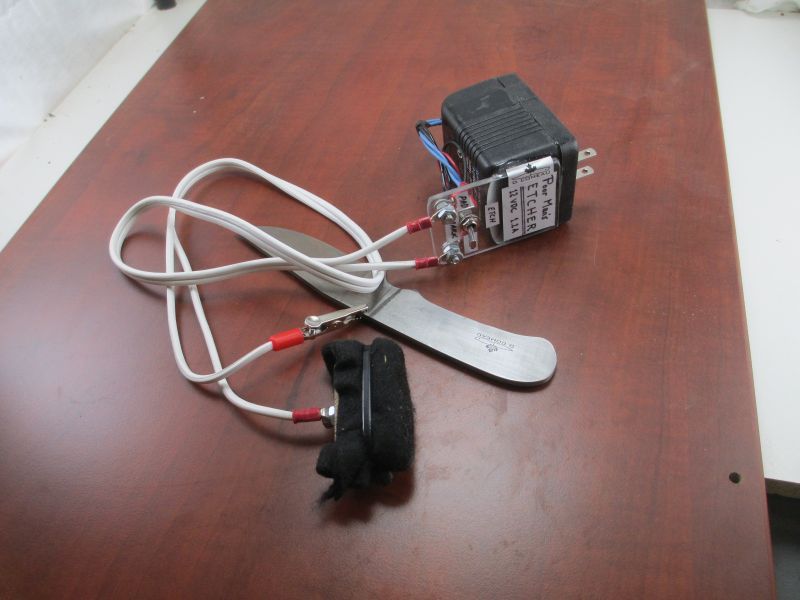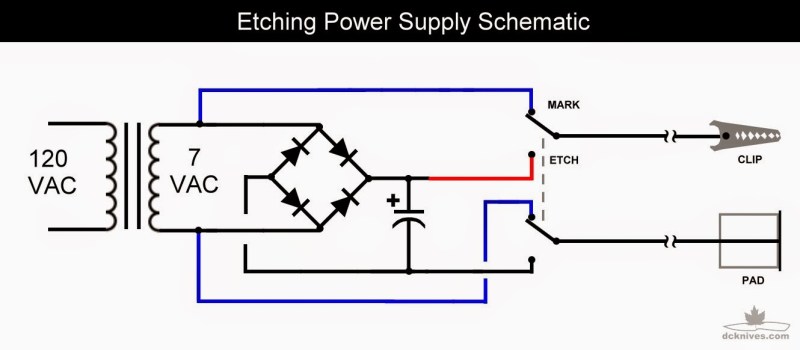[Dan Comeau] is a modern-day Renaissance DIY Jedi — or so he says… He loves re-purposing things and hacking in general. But one of his favorite pastimes is producing custom hand-made knives. He etches his logo on each, using a professional etching machine, but when a fan asked how to do it themselves, he came up with this simple and easy way to etch metal at home with a few things you probably already have!
It’s actually incredibly simple. Just by cracking open a DC power supply (a wall wart will do just fine), you can easily make your own etching/marking device with a few modifications. Ideally you want something in the range of 5-12VDC at 1A or more.
By soldering in a few wires to a double-pull, double-throw switch, you’ll be able to easily switch between low voltage AC and DC which will allow you to either mark (AC) or etch (DC) the steel with the help of an electrolytic solution on the pad. Take a look at his blog for full details, or the Instructable he just wrote up!
We have seem a very similar method of knife logo etching before. Alternatively if you don’t have a DC power supply handy (seriously?) you can always use a 9V battery!

















I think you mean a “double-pole double-throw” switch.
Double-POLE switch, not double-PULL!
Ah, the pain of spelink korruption.
siriusly. Are the HAD authors just random bums off the street or do they have anything whatsoever to do with electronics?
Just be thankful this one wasn’t one of Mike’s.
i’m sure HAD would accept a guest column from you at any point if the current material sucks so bad…
DPDT would have been just fine, too. ;P
i thought amoung other tings stood for push up for on,
pull down f or off switch ;)
Naa, it’s flip up for on and flip down for off.
You might want to add that it needs to be one of the heavy, old kind of wall warts that actually contains a transformer. Nowadays most of them are with switching power supplys, so there won’t be an ac-Mode.
True, but I think most HaD users would get that, and there is a transformer in the diagram.
The schematic shows a filtering cap which would make this a DC supply, which is also stated in the text. A switching supply should still work I suspect….switching supplies are short circuit protected by design, so that might effect the operation……as long as the load current stays low relative to the rated current it should function the same. In fact the chances of damaging a switched mode supply would be less than a linear one, I would suspect.
Or if you read his blog, on the front page, the use of an AC adapter & diode which would be somewhat easier as it’ll be a transformer for sure (99/100 if AC:AC it’s going to be a transformer) and no hacking it apart required thus n00bs avoiding death etc.
NooB Death, nice name for a band
My bedside lamp is a 12v halogen. I once connected a 12v LED array to this and it flickered, meaning AC current.
You could hack that for your AC and build your own rectifier without damaging the lamp!
Natural Selection can only work if we give it the opportunity.
No video?
I’ve done similar stuff to lead miniatures to simulate battle damage using a model train power pack
you don’t need any of this. 2′ of wire and a clip, a 9v battery, a q-tip and some salt water all for < $2. But to make it nice you need an etched stencil.
i don’t understand, what is “mark” an “etch”, and what is the pad made of, how do you make your text ?
DC = etch (eats away the metal)
AC= mark (leaves black deposits to make more visible)
the DPDT switch lets you select what legs on the bridge rectifier you use (either AC or DC)
Those comfortable wiring at line voltages could find 120 -> 10-16V transformers in their scrap bin or favorite electronics store. They’re used in older door bells so you may be able to get one for free if you know someone remodeling.
Be smart and use a GFCI around liquids. It’ll keep the insurance people happy.
Choose carefully in order to meet the recommended current threshold. Cheap-o 16v 10w (va) transformers won’t provide 1A. You’d want to find a multi-chime rated transformer that is rated for 8v 10w (common), 16v 20w (semi-common), or 24v 50w (rare).
Minor correction that I myself just learned about. In this case VA may not directly equal watts since the two legs of the transformer may be out of phase with each other in which case you have to multiply by the phase angle. So the VA rating should be taken as the max wattage, not necessarily delivered wattage.
ffs. non-unity power factor is when the current and voltage are out of phase, i.e. the load is not resistive. the “legs of the transformer” cannot be out of phase with each other, they are just one phase.
Given that we’re talking about acid baths here, the load is real/resistive (no capacitive or inductive component) and power factor should be 1.
Guess I get to learn two things today.
Cheers!
Correct, a purely resistive load does not have an inductive or capacitive component, so VA is equals to Watts in this case.
Does anyone know how the template (that he bought) was made?
Any insulator will work. You just need a way to fix it to the metal and prevent electrolyte from getting under it. That will create a similar effect as underspray in painting.
You could use masking tape, label paper, laser-cut vinyl, again any insulator you can adhere to the blade.
Thanks He was a bit quick with the nail polish bit . I didnt pick that up at first . It needs a bit of explanation in his article . Could not leave my comment there as the old jump through hoops approach prevails on comments there.
what are you using for the etchants and solvents?
and can this be used to extract metals like gold from electronics?
for simple etchants you can use saturated salt water, but for good marking, there are a plethora of different sulfate solution commercially available to suit almost all the available metal.
I think he needs to seriously reconsider his name “dcknives” I read it too fast and well I thought it was naming the purpose or target of the knife. Just saying.